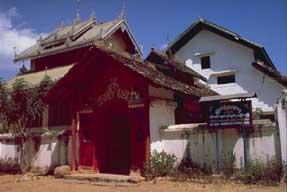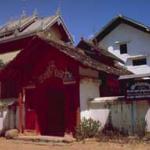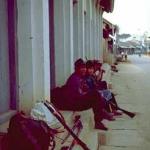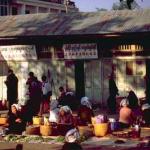The Shan States of Burma: Toyotas, Traders, and tribes
I bought a young jungle cat in a northern Burmese town, where it faced its fate in the market along with pangolins, baby birds of prey and reptiles. It now eyed me warily from its makeshift cage in the backseat of the truck. Bargaining for it was simple where exotica was commonplace and commonplace was trade. I felt not the absence of laws in the Shan States, a borderland of diverse races and faiths, social and political systems, wedged between Thailand and China, but the unlawfulness of existing ones, so layered and variable that I looked to Joe for instruction.
Joe shared the animal's cost and agreed to care for it when I departed for home. I had found Joe in Mae Sai, the Thai town connected to Tachilek, Burma by a short bridge, where he operated a guesthouse and a Toyota truck in which he negotiated, for those who hired him, the arduous road between the Thai and Chinese borders--the extent of permissible travel within the Shan States for tourists. Offering alternative transport to the aging station wagons known as "rabbits" that waited for passengers in the Tachilek market, Joe spurred his vehicle over collapsing bridges and squeezed by stalled lorries with only a hair between himself and the edge of a precipice in a show of western bravado and Eastern mysticism. He avoided political opinions like potholes. I suspected that if change eliminated the frontier's challenges, this trader in fringe tourism would move on like a nomad.
When I last stood on the Mae Sai bridge ten years ago, costumed young minority girls offering themselves as photographic subjects were my only glimpse of the forbidden northeastern corner of the Shan States, once dissected by caravans of itinerant businessmen. Now I walked uncontested across one of two open land crossings into Burma, but first I had to relinquish my passport to Burmese immigration to ensure that I exited the same way I entered. In exchange, I was issued a pink permit that filled up with the signatures of the authorities who monitored my progress over five days.
There was a reason for the circumspect officialdom. The Shan States are home to Ahka, Kachin, Lahu, Palaung, Pa-O, Shan and Wa minorities, each with its own language and culture. Their rebellious conflicts against central rule and each other have involved a confusing assortment of partnerships and players, including the Burmese army, communists, criminals, hilltribe militia, and exiled National Chinese soldiers. Secessionist movements supported themselves by selling opium. The Mong Tai Army for Shan liberation, under the leadership of Khun Sa, controlled opium production for twenty years. Skirmishes between the MTA and Burmese troops kept the road we were to travel unsafe, even after its official opening in 1993, until Khun Sa's unexpected resignation of leadership in 1996. A solitary slip of paper was now my passage in.
The decision to visit Burma, a country whose dictatorial leadership has been condemned by foreign governments, was weighed against not experiencing more of a country and people that I had enjoyed on two previous trips. I lit incense for my Shan-style Buddha--the impetus for travel to the Shan States in the first place--and left for Keng Tung via Mae Sai.
The road was under repair; the labor crews, in this time of relative peace, were hundreds of dust-coated Burmese soldiers in floppy bush hats who manually reduced to fragments the cairns of stones that waited along the road's length, collected from the river that twisted its way through the bamboo-forested valleys by minority villagers who were expected to contribute them, or money. The road's upgrading seemed doomed to fresh starts after every rainy season threatened to revert it to the muddy, narrow pony track it was for five centuries, a 240-kilometer route for Chinese mule caravans that cut across Burma and Thailand with products bound for Bay of Bengal ports. Burmese internal events in the 1960s and a deteriorating relationship with China over opium brought about their end. The restoration of economic ties between Burma, China and Thailand has revitalized the road as a trade corridor, but motorized transportation now conveys everything from building supplies and electronics to gemstones and women from either tortuous end.
Keng Tung was the first destination within Burma for the old caravans originating in southern China, after which the route separated into two, one entering Thailand at Mae Sai, the other near Fang, rejoining again at Chiang Mai. Holt S. Hallet, in search of a railway route for British goods between Burma and China, noted in his 1890 book "A Thousand Miles on an Elephant in the Shan States" that up to 8,000 laden animals arrived yearly in Chiang Mai from Keng Tung. The Chinese traders carried camphor, dates, silk, tea and walnuts, and returned with cotton, lacquerware, precious metals and tobacco. They brought their religion as well, having been converted to Islam by the Mongols. The Panthays, a Moslem minority group in the Shan States today, are descendants of caravan drivers.
Keng Tung was also our first stop which we reached after dark. Eleven hours of a vibrating vehicle lengthened the 150 kilometers between it and Tachilek, and sweeping hillside fires of swidden agriculture dramatized our arrival, creating mental phantoms that dissipated with daylight and sleep. At dawn, I followed a flow of people to the central market.
In his 1930 travel book "The Gentleman in the Parlor," W. Somerset Maugham devotes two chapters to the market when he rested in Keng Tung after a four-hundred-mile pony trek through the Shan States. At the time, it was held once every five days. Now permanent, the market was larger than what Maugham describes, and comparatively less exotic despite its many hilltribe customers, who lived in villages around Keng Tung. Maugham encountered Shan musicians with bamboo instruments and caught in their music "the impression of something immensely old." I saw no musicians, and heard their melodies only on scratchy cassette tapes, but in the aisle for money exchange, men were selling Burmese kjat, Thai baht and Chinese yuan for another currency still viable for cross-border trade from the caravan days, old silver Indian rupees sold in India as souvenirs. I scooped up a handful and didn't find one dated later than 1918.
Music far older than the caravans--religious gongs, chants and bells--led me away from the market to Wat Zom Kham where I sat on cool, floral tiles and listened to a ten-year-old novice monk intone sacred scriptures. When he tired, another boy began; a cycle of prayer in place since a hermit Tunga, foretold by the Buddha himself, shrunk a lake with his magic and a devout city named after him rose where once was only water. The murky natural pond in the middle of Keng Tung is the basis of the folktale, its thirty-two monasteries and pagodas final fulfillment of the prophecy. Six hairs of the Buddha are enshrined in Wat Zom Kham's pagoda, left as relics, it is said, when Buddha, ancient wanderer, came to the Shan States.
An elderly Shan gentleman at Wat Zom Kham, who addressed me in the formal English taught him by Italian nuns sixty years ago, welcomed me. I was later to visit one of Keng Tung's missions where its refectory wall displayed the photos and biographies on of the sisters who served and died there. In the hilltribe villages around Keng Tung, I saw simple Catholic or Baptist churches, empty but for mats on earthen floors, evidence that conversion was, for the most part, more successful among animists. The Shan, who belonged to the great Buddhist Lanna Kingdom of 13th and 14th century Thailand, remained unpersuaded, their pride in shared ethnolinguistic ties with the Thai unbreakable.
The Thai king who founded Chiang Mai enclosed Keng Tung with a wall, from which evolved the town's final meaning, "The Walled City of Tung." With an original circumference of seven and a half miles and with seven gates, all that remained was a single arch. In 1991, Keng Tung lost another historical landmark, the teak palace or haw of a Shan prince called a saopha, the last descendant of a dynasty that had existed since the Burmese conquered the Lanna Kingdom in the sixteenth century, arguably the time when Burmese and Shan enmity began. Its whimsical towers and domes, a symbol of Shan nationalism, that survive in a faded photograph sold clandestinely in Keng Tung, were torn down and replaced with what the Burmese thought more appropriate, a multi-storied hotel. A residence of a lower-ranking prince remains for travelers to view from the outside, its current occupants, United Nations Drug Control Program staff, no less significant today as royalty was in the past.
Departing Keng Tung for the eighty-kilometer journey to the Chinese border, we left the semblance of history for a glaring present. All the mountains within view were naked, bristly stumps their solitary cover. When the road continued to climb, I looked down on villages on exposed summits as a hawk might on vulnerable prey. Shifting cultivation practiced by hilltribes was one reason for the deforestation, demand from the military another. A quota of timber was required from his wife's Wa village, said Joe.
Pictures of Joe's marriage to his Wa bride, held in her village, hung on nails in her parents' hut. His mother-in-law was Joe's age with a toddler of her own, a younger uncle to his daughter. The Wa were friendly and talkative. Many had children working in service trades in northern Thailand, the new brick houses among the traditional wood and thatched ones built with the money they sent home. Young women with long tendrils of white flowers inserted in their black turbans posed for photographs.
Accounts of early travels through the Shan States mention the Wa and the need to avoid them. The Wa's ancestors who didn't convert to Buddhism were headhunters, believing that a human skull, particularly that of a stranger, protected their villages, crops and hunting grounds. Animal skulls are still used as amulets, as we saw in a headman's house in another Wa village, after bartering for our entry by buying samples of his wife's weaving. She fluttered around us as we looked at the deer skulls attached to a pole, old bows and arrows, and calling drum, concerned that we would bring illness to her home if we touched the artifacts.
The Wa no longer take human heads, but their reputation for ferocity remains. The road itself was a sign of Wa power and prosperity, an improvement over its counterpart between Tachilek and Keng Tung because its construction and upkeep were their responsibility and no longer the Burmese military's. It led to "Wa Land," their semi-autonomous region. Technically a part of Burma, within its confines the Wa have their own army, flag and license plates. They control all activity on the road. At a bamboo roadblock, we paid the hefty fee of $12 US levied against all vehicles entering and exiting Wa territory. Wa independence was gained with the collusion of both the Burmese and Chinese. As opium producers, they were Khun Sa competitors tolerated by the Burmese as terms of a cease-fire; upon his retirement, they have reportedly replaced him.
Mongla was the Wa "capital" and our final destination. Its recent developments--a grand hotel, an even grander Buddhist temple, a bridge, a beer garden and a nightclub for a Thai transvestite cabaret--made a different statement about the current players in the region's drug trafficking. The crowning centerpiece was the equally new, startling pink, anti-narcotics museum. A Mongla tourist attraction, complete with souvenir shop, it was full of Chinese day-trippers who were whizzed by guides around rooms of photographs of politicians at the burning of poppy fields, the destruction of refineries and the seizure of heroin shipments and weapons. Khun Sa's retirement was referred to as returning to the "legal fold."
The enormous standing Buddha on the grounds of the new hill temple towered over Mongla, the gesture of outstretched arm and pointing finger less beneficent than vigilant. Compared to Keng Tung, the town below was a metropolis, its faces, temperaments and habits recognizably Chinese. Gambling was its social life, a tepid shower in a Chinese bathhouse the alternative to a bucket of icy well-drawn water and strident Chinese vendors in the market sold jade, plastics, poultry and meats.
We stayed with a quiet Shan family, in their wooden house hidden behind the main street. Comfortable in my blankets on the rattan floor, I watched the family members rise early and work in the light sneaking through gaps in the raftered ceiling. The mother tended the cooking fire and the grandfather filled baskets with sticky rice. Joe had made eighty trips to the Shan States with passengers but that morning I felt part of an enormous secret. It was easy then to mistake Mongla for Keng Tung, to see them as outposts where the strangeness of place never wore off: the Shan monk rendered invulnerable by tattoos that concealed him like a diver's wetsuit; Palaung villagers poring over photos of themselves in a recently published book; the thousand strong gaggle of ducks herded by a solitary farmer from China to Keng Tung; the reports of a tiger menacing a mountain hilltribe village. Here the oddity of life matched its hardships.
Shortly before our arrival in Mongla, a twenty-year-old woman, a wife and mother, a neighbor of our Shan hosts, had died of illness. It is Shan custom that the dead be buried by sunset and under the house, men were quickly fabricating a coffin. The Shan accepted us as witnesses of their grief: I saw their belief in the immutability of life, as well as their courage of forbearance. I had no such tolerance. When we chanced upon the tiny wild cat in the market the following morning, I intervened in its destiny because I could. I was aware, however, that in the Shan States, my action was simply business as usual on an ancient trade route.
 ThingsAsian
ThingsAsian


















